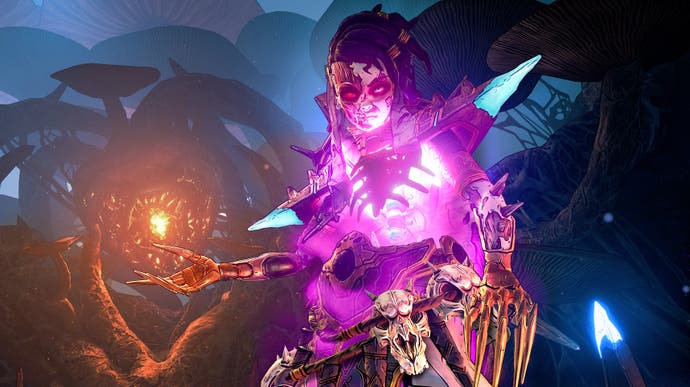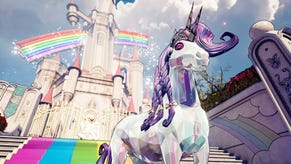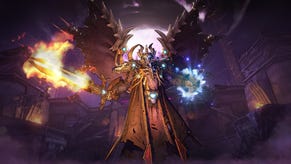Tiny Tina's Wonderlands review - happy vibes and hodgepodge design
Magic the blabbering.
At times, playing Tina Tina's Wonderlands can feel a little like working through a hangover. This is a game with UI that reads like brain fog, clouding out mechanics with half-tooltips and miniature smallprint and systems that are occasionally hinted at but rarely explained. It's also loud, in every sense, all booming explosions, yelling voiceovers and broad splashes of the high-contrast, primary colour scheme it paints jarringly over the world's otherwise slushy, sludgy browns and greens. A lot of noise. A lot of energy. A lot of ibuprofen and coffee needed to figure it out.
There are a lot of examples of this kind of shouty-but-opaque approach to things in Tiny Tina's Wonderlands. One of them is the game's main collectible, Lucky Dice, which are nice, shiny gold D20s dotted around the world like the good old relics of a 3D platformer. When you find one and interact with it it rolls, popping out some loot and a number between 1 and 20 that determines something called your Loot Score. I've played a fair bit of Tiny Tina's Wonderlands now, and I do not know what that is. I'm assuming higher rolls are good - Tina likes to remind me it means better loot - but do they stack, or add up as I collect more dice maybe? Does it just reset to whatever the most recent roll is? There's a very different number buried in my character's menu screen, but how do the dice I find and roll play into that? Again: not a clue. But it's there, it looks a bit Dungeons & Dragons-y, and it's shiny and kind of fun, in that vacant, loot-make-brain-feel-good kind of way.
This is Tiny Tina's Wonderlands, a Borderlands spin-off that is still very much Borderlands. The history here starts with Tiny Tina's Assault on Dragon Keep, a bit of 2013 Borderlands 2 DLC that then became a standalone game of its own last year, and now acting as the jumping-off point for Wonderlands as a fully-sized standalone game. The setup is that you, an unnamed "newbie" in the real, Borderlands world, are playing a D&D-like game called Bunkers and Badasses with a couple of friends, and Tina acting as Dungeon Master.
It's not the first game-within-game concept, and definitely not the first D&D video game, but it's a promising setup and it kicks off well. That character customisation is excellent, for one, full of sliders nudging you towards look-what-I-made ridiculousness but also some welcome nods towards the things that make D&D the famously inclusive hobby that it is, with simple things like gender-neutral ways to refer to your character and "this one" or "that one" body types. The end result is - at least appearance and personality-wise - that anyone can set up any kind of character they want, which is exactly as these kinds of roleplaying games should be. And then beyond that there's some satisfactory depth for a casual RPG.

There are six classes - Brr-zerker, Clawbringer, Graveborn, Spellshot, Spore Warden and Stabbomancer - each with the typical unique passives, ultimate-style skills and skill-trees of their own, but with at least a couple of those breaking out from the traditional fare of archer, rogue and co to slightly more interesting things like dragon summons and floating allied skulls. Generally, these classes all mix an elemental kind of damage like ice or poison with their own skills, and while you can use any kind of weapon with any class this is ultimately a game about min-maxing if you want to make much headway.
This gets better, as most things do in Tiny Tina's Wonderlands, as you get deeper into the game. A good chunk of the way in you'll unlock a secondary class, which, if you're smart, can complement your main one nicely. There's also a character background system, which gives you a little boost to one or two stats and a nerf to one or two others - the "Village Idiot" background, for instance (Archetype: Thicc) gives you some extra Strength points, which boosts your weapons' crit damage, while reducing your Intelligence, which means your spells take longer to cool down.
This is a small thing for anyone who regularly plays RPGs but a nice touch for what is a relatively mainstream game. The whole stats-behind-the-stats business of character archetypes tends to be the first thing on the chopping block when RPG mechanics are whittled down to the ubiquitous RPG-lite - see the shift from The Elder Scrolls: Oblivion to Skyrim, for instance, and seemingly every big-budget open world under the sun since. Having that system present feels like a welcome little treat.
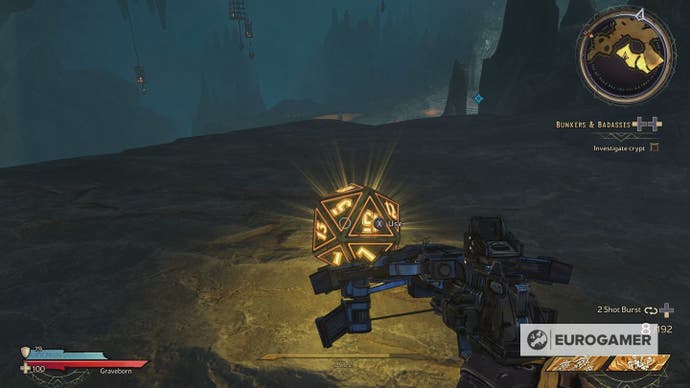
Each time you level up you get a point to put into your skill tree, standard, and a point for those stats, up to a cap for each, with it all feeding back into character-building - and for the most part it works quite nicely. My Graveborn-class character has an ultimate that spends HP in order to dish out massive damage, but I've also maxed out his Intelligence, meaning I get to spam spells quickly, and those spells all do bonus Dark Magic which heals him, and kills spawn little allies which do more Dark Magic which heals him for more, etc. etc. When this kind of cyclical, stacking buff-loop works it's always a treat, whatever the game, and the good news is it's absolutely possible to set that up with Tiny Tina's Wonderlands, albeit after those slow few hours at the beginning.
Where Wonderlands falls down is where it tries to be cleverer than that, though, and given how fundamentally simple and repetitive combat can become at times, this can be an issue. Different enemy types have different elemental weaknesses or resistances, for instance, but what if your build is geared towards a certain type, as you're nudged into doing by your class and all the rest? The solution is to switch guns - you can carry up to four, the extra slots slowly unlocking as you progress - which is fine if you're one of the guns-first classes, less so if not. You get one spell, mapped to LB, and that one ultimate to RB, and that's your lot.
There's no way to swap out spells quickly without stopping, digging into your backpack and manually changing them mid-battle - same with melee; just one melee item mapped to clicking in the right stickl. It leaves non-shooting builds feeling like an afterthought, spells essentially just taking the role of grenades. I haven't played as the melee-focused Brr-Serker but I dread to imagine what it's like building an entire character around the mechanical equivalent of clonking someone with the butt of your gun. And similarly, the lack of ability to swap these things on the fly like your guns means the whole elemental system becomes kind of moot. My solution was to just put even more points into spell cooldowns and press LB even more often, while making sure I did at least have a functional gun to tick me over in between.
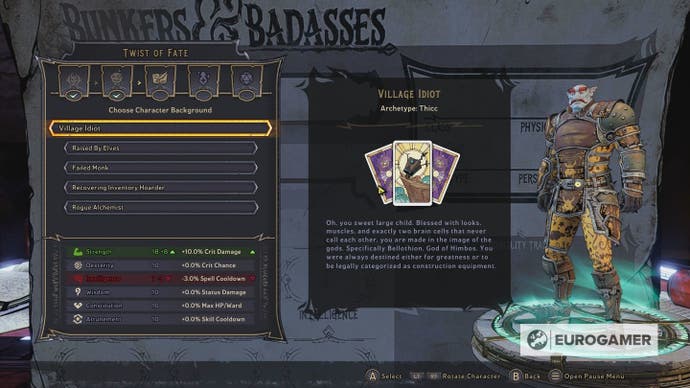
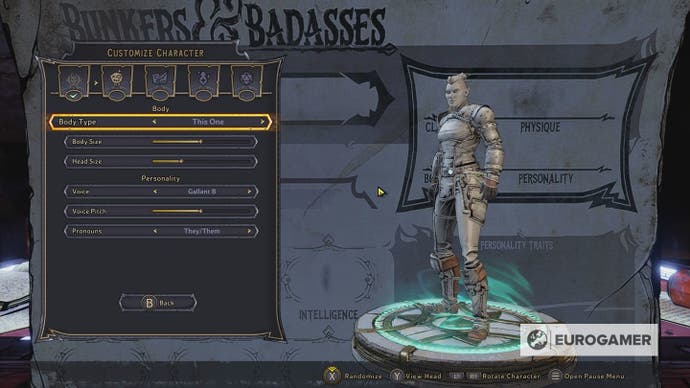
This leads on to the other main issue, which is inventory management - and it is dreadful. It's been a long time since Borderlands 2, which was the last one I properly played. A long time for UI to evolve and change and, crucially, improve. Regardless of what year it is though it is just fundamentally not enjoyable to spend any time whatsoever going through dozens and dozens of looted tat to manually label it as "Junk" (we're close to an epiphany with that label) then travel to a selling station to bin it off for a bit of coin and go again.
Doing this efficiently - doing it in a way that's necessary if you care about builds and playstyles and all the things that this game is ideally hoping for you to care about - means manually selecting your active item in a slot, say your amulet slot, in order to bring up the comparison graphic; then cycling through each other amulet in your all-too-small backpack to closely analyse the fine-print of what it does, which often excludes some crucial info beyond the little percentage numbers; then marking each less-good one for sale; then unselecting the original and moving to the next item slot. And repeat, repeat, repeat, for each item slot you have; and then sell. And then repeat this whole process between every quest or sidequest - or really, every single time you pass a vending machine that'll let you do it.
The result is me actively dreading the loot I get as a "reward" for playing because of the sheer amount of admin I'm set for afterwards. When a game like Tiny Tina's Wonderlands is built on the extrinsic drive of shiny loot to drag you through a main mission - or a side one, the process sometimes openly labelled as a grind - a player dreading the actual loot part is less than ideal.
Fundamentally, it's a linear follow-the-waypoint shooter set in an open world and wearing some D&D cosplay, and that feels like a waste.
That's compounded, too, by even main missions that do feel like a grind at times, rarely deviating from you blasting your way to a boss through lengthy, recurring waves of enemies. The world you gallop through is fun, overtly stupid, buffoonishly parodying every fantasy story you can remember, often in a very uninventive, unfunny way, mind, but still enthusiastically, if nothing else. And those enemies themselves are comically diverse and refreshingly bizarre, reflecting, like the world, the chaotic playfulness of Tiny Tina as Dungeon Master - and by dint of that, developer Gearbox itself. There are some recurring archetypes - run at you, shoot at you, tougher version, version that explodes - but visually they're a laugh, often comically horrible to look at, and with a smattering of weird, belching blimps and sentient-eyed cyclops there's enough variety there to keep you going.
The main issue is the structure. Tiny Tina's Wonderlands takes place on a number of local maps, which are within bigger regional maps, which are within a big overworld map that also has another map depicting that. The overworld seems totally unnecessary, an extra layer that just seems to be there to make room for more, often limp meta-jokes about Tina making it up on the fly, plus a few very basic environmental puzzles and numerous, generic-feeling dungeon horde encounters. Combine that with the main story and longer sidequests, and the sheer number of times you'll need to follow a waypoint through several encounters at explosive barrel-strewn clearings to larger clearings with more encounters, and things can get really quite boggy.
It doesn't pair well with the fairly button-mashy combat of caster classes, brought about by a mix of that severe visual chaos. Effects can really kick off at later levels, at least with the mix of spell-wielding classes I chose and the more interesting, typically Borderlands gun designs that spawn all kinds of added on-screen carnage. And there are some more UI missteps: essential information on your stacking combos, for instance, that are central to most builds, are only shown with a teeny tiny marker for ants at the bottom of your screen. The basic goal of: do lots of damage and cause some pleasurably bright but shallow chaos is fun. Do that dozens of times in similar places with similar events in similar order, and it wears thin.
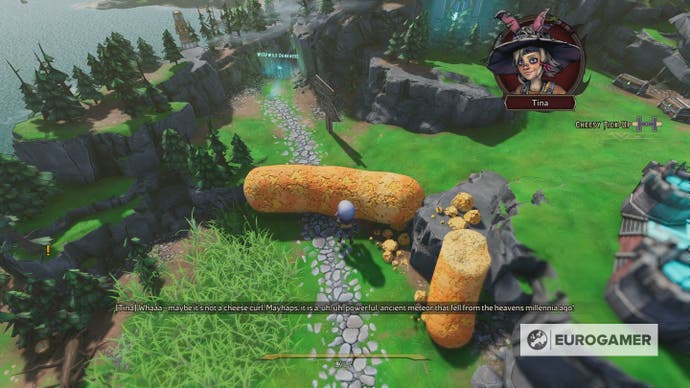
Finally, there is Tiny Tina's Wonderlands' tone. Borderlands' humour, certainly by the time of 3, has become divisive at best, and Wonderlands continues on with pride. Sometimes it is genuinely funny - combat barks are a real highlight, undead characters perpetually shocked and confused that they're dying ("again?!") - but it's hard to think of a better example of a game shouting over itself. Wonderlands will literally do this, characters waffling, bellowing, shrieking in endless, reaming paragraphs of non-dialogue before another has finished, before you can progress a quest, end a quest, start another. Nobody is actually making any jokes here, just speaking in that Whedonesque "joke tone", the tone that implies a kind of baked-in humour, but rarely seems to actually follow it up with a punchline. I've come to realise - especially with subtitles turned on, displaying the literal paragraphs of text across my screen mid-battle - that the series actually doesn't use music in the traditional sense. The dialogue is the soundtrack. I would prefer music.
That said, Wonderland's core cast is stellar and for once, Hollywood talent does translate to voiceover quality here. Wanda Sykes is brilliantly rigid as robot character Frette, taking on the role of your lawful D&D literalist friend - the type who casts "identify tree" on the first fallen tree you encounter, that's just there to teach you how to jump. Will Arnet, of Bojack Horseman and Lego Batman voice fame, hardly has the nuance of Bojack to play with but is on good, smarmy form as the big villain. And Brooklyn-99's Andy Samberg does his usual vain-but-self-deprecating-guy thing.

The issue there is they rarely get a chance to really shine as a party, because fundamentally they aren't one. You play this game alone, a single character on the map, unless with actual real-world friends partied up. Frette and Captain Valentine don't join you as actual characters, and at no point do you do the things a D&D party actually does. Puzzles are solved by Tina dropping in an improvised solution ex-machina, which starts as a sort of purposeful bit that the game is doing, making light of how fly-by-the-seat-of-your-pants Tina's Dungeon Mastering is, but then actually just becomes a problem. There's no decision-making, no improvisation, no teamwork, not a hint of interlocking systems beyond your strictly combat-only skills, weapons and gear. Fundamentally, it's a linear follow-the-waypoint shooter set in an open world and wearing some D&D cosplay, and when the action itself can be hit-and-miss, that feels like a waste.
It's Ashly Burch's character of Tiny Tina that sums it up best. She's earnest and committed, regularly overdoing it with a character that's intentionally designed to be painfully shrill. But Tina's also sympathetic somehow, through all that noise. She's likeably up-beat, innocent, goofy, in the way that implies character - the way that someone young or vulnerable can be to cover up some wound and project a bit of teenage nonchalance. The goofiness is not always endearing but again, that's baked into the character. And it's baked into Tiny Tina's Wonderlands, and the wider Borderlands world.
That's really all this game is. Something scrappy, irritating, giving the impression of something stitched together on the fly - but at least it's still earnestly, chaotically, relentlessly upbeat as it dutifully scrambles along.
